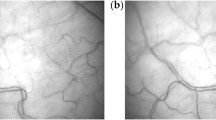Abstract
Nailfold microcirculation can reflect the state of health. It is an important research topic to detect the change of microcirculation blood flow velocity. In order to save cost, people usually choose the low-cost micro camera to collect samples. However, the microvascular video collected by such camera is often disturbed by various noises, resulting in poor contrast and clarity of the image. Due to the large number of microvessels, it is time-consuming and laborious to detect the blood flow rate manually, which is inefficient and difficult to accurately detect the subtle changes of the blood flow velocity. At present, the previous research of blood flow velocity detection is mainly focused on the clearer microcirculation video. It is difficult to find any related research of blood flow velocity detection for noise image. For the low-quality nailfold microcirculation video collected by the low-cost microscope camera, we propose an automatic detection method of blood flow velocity based on projection analysis of spatiotemporal image. The method is as follows: firstly, video preprocessing, correlation matching are used to remove jitter and image blur is eliminated by deconvolution, the row mean is used to eliminate reflective area by analyzing the characteristics of noise distribution; secondly, we use cumulative background modeling to segment blood vessels and propose an automatic detection algorithm of blood vessel centerline; thirdly, the direction of binary spatiotemporal image is detected by using rotation projection, and then the blood flow velocity is calculated. The experimental results show that the proposed method can detect the blood flow velocity of microcirculation automatically and efficiently. Meanwhile, the average correlation coefficient between the proposed method and the manual measurement standard value is 0.935.
Access this chapter
Tax calculation will be finalised at checkout
Purchases are for personal use only
Similar content being viewed by others
References
Gurfinkel’, I.I., Sasonko, M.L., Talov, N.A.: Correction of blood microcirculation parameters and endothelial function in chronic venous insufficiency of lower limbs. Angiol. Vasc. Surg. 23(2), 89–98 (2017)
Kulikov, D., Glazkov, A., Dreval, A., et al.: Approaches to improve the predictive value of laser doppler flowmetry in detection of microcirculation disorders in diabetes mellitus. Clin. Hemorheol. Microcirc. 70(11), 1–7 (2018)
Hu, G., Zhai, F., Mo, F., et al.: Effectiveness and feasibility of nailfold microcirculation test to screen for diabetic peripheral neuropathy. Diab. Res. Clin. Pract. 13(1), 42–48 (2017)
Sallisalmi, M., Oksala, N., Pettilä, V., et al.: Evaluation of sublingual microcirculatory blood flow in the critically ill. Acta Anaesthesiologica Scandinavica 56(3), 298–306 (2012)
Poree, J., Posada, D., Hodzic, A., et al.: High-frame-rate echocardiography using coherent compounding with doppler-based motion-compensation. IEEE Trans. Med. Imaging 35(7), 1647–1657 (2016)
Held, M., Bender, D., Krau, S., et al.: Quantitative analysis of heel skin microcirculation using laser doppler flowmetry and tissue spectrophotometry. Adv. Skin Wound Care 32(2), 88–92 (2019)
Rosenson, R.S., Chen, Q., Najera, S.D., et al.: Ticagrelor improves blood viscosity-dependent microcirculatory flow in patients with lower extremity arterial disease: the Hema-kinesis clinical trial. Cardiovasc. Diabetol. 18(1), 77–85 (2019)
Chen, H.F.: Quantitative measurement system of microcirculation velocity. Zhejiang University (2002)
Liu, Y., Yang, J., Sun, K., et al.: Determination of erythrocyte flow velocity by dynamic grey scale measurement using off-line image analysis. Clin. Hemorheol. Microcirc. 43(3), 263–267 (2009)
Sheng, Y.M.: Research on dynamic measurement technology and application of micro image characteristic parameters of microcirculation and myocardial cells. Peking Union Medical College (2011)
Chen, Y.: Measurement and recognition of human microcirculation parameters based on image analysis. Nanjing University of Aeronautics and Astronautics (2012)
Lv, F.: Development of microcirculation blood flow analysis system based on video image. Southeast University (2015)
Wang, Y.: Research on microcirculation parameter measurement algorithm based on video image. Southeast University (2017)
Dong, J., Liu, H.: Video stabilization for strict real-time applications. IEEE Trans. Circ. Syst. Video Technol. 27(4), 716–724 (2017)
Pan, J.: Motion blur estimation: theories, algorithms and applications. Dalian University of Technology (2017)
Wang, J., Shi, G., Zhang, L., Han, B.: Methods to suppress edge ringing in motion blurred images. Electron. Measur. Technol. 36(05), 62–67 (2013)
Liu, S.: Study on medical image enhancement based on wavelet transform fusion algorithm. J. Med. Imaging Health Inform. 7(2), 388–392 (2017)
Magudeeswaran, V., Singh, J.F.: Contrast limited fuzzy adaptive histogram equalization for enhancement of brain images. Int. J. Imaging Syst. Technol. 27(1), 98–103 (2017)
Zhang, X., Liu, Y., Zhou, J., et al.: Study on QR code image binaryzation under non-uniform lighting conditions based on grayscale morphology. IEEE Computer Society (2012)
Kupyn, O., Budzan, V., Mykhailych, M., et al.: DeblurGAN: blind motion deblurring using conditional adversarial networks. In: IEEE Conference on Computer Vision and Pattern Recognition (CVPR) (2017)
Misyura, M., Sukhai, M.A., Kulasignam, V., et al.: Improving validation methods for molecular diagnostics: application of Bland-Altman, deming and simple linear regression analyses in assay comparison and evaluation for next-generation sequencing. J. Clin. Pathol. 71(2), 117–127 (2018)
Acknowledgement
Supported by The National Natural Science Foundation of China (61701192); Shandong Provincial Key Research and Development Project (2017CXGC0810); Shandong Education Science Plan “Special Subject for Scientific Research of Educational Admission Examination” (ZK1337212B008); Shandong University Science and Technology Program “Research on Navigation Technology of Wheeled Robot Based on Binocular Vision” (J18KA371).
Author information
Authors and Affiliations
Corresponding author
Editor information
Editors and Affiliations
Rights and permissions
Copyright information
© 2020 Springer Nature Switzerland AG
About this paper
Cite this paper
Lin, Z., Zheng, F., Ding, J., Li, J. (2020). Blood Flow Velocity Detection of Nailfold Microcirculation Based on Spatiotemporal Analysis. In: Peng, Y., et al. Pattern Recognition and Computer Vision. PRCV 2020. Lecture Notes in Computer Science(), vol 12305. Springer, Cham. https://doi.org/10.1007/978-3-030-60633-6_57
Download citation
DOI: https://doi.org/10.1007/978-3-030-60633-6_57
Published:
Publisher Name: Springer, Cham
Print ISBN: 978-3-030-60632-9
Online ISBN: 978-3-030-60633-6
eBook Packages: Computer ScienceComputer Science (R0)




